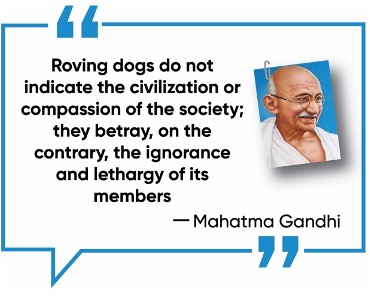Introduction
India has a nearly 1.5 crore stray dog population (2019 livestock census) and carries the dubious distinction of being the world’s dog-bite-and-rabies-capital. According to the National Crime Records Bureau, there were 4,146 reported cases of dog bites leading to human deaths in India in 2019. Thus, there is a growing concern regarding stray dog management.
Stakeholder | Interest/Role |
Animal welfare organizations/ activists |
|
Pet owners |
|
Local authorities |
|
Government |
|
Ethical aspects surrounding control of stray dogs
- Abandonment: Abandonment of pets is a moral challenge, which is often considered as moral bankruptcy and irresponsibility.
- Socio-economic changes in human societies have rendered the historical roles of hunters and herders largely obsolete.
- Thus, theutilitarian component has weakened significantly in the human-dog bond that has evolved over thousands of years.
- Differential treatment: There are concerns regarding the differential treatment of different categories and breeds of dogs. Why do some well-bred animals are seen as status symbols, and treated like family members, while others living on the streets are seen as social outcasts?
- Companionship and responsibility: Dogs have a unique relationship with man’s evolutionary history — one of companionship. This poses a moral dilemma of being responsible for their welfare but also confronting the vagaries of their evolution from wolves and their territorial instincts.
- Public Health: The concern is raised for both human health and the health of dogs.
- Also, India has committed to eliminating rabies by 2030, but it is not possible without first addressing threats from stray dogs.
- Ecological concerns: Carrying capacity of the environment is the population of a species that can be supported by a particular environment given the limite resources.
- Some believe that humans are directly increasing the capacity of stray dog population by regularly feeding them, thus aggravating the problem.
- Animal control methods: The use of capture, mass killing and euthanasia methods raises ethical concerns, as it involves taking the lives of animals. Ethical alternatives, such as trap-neuter-return (TNR) programs, should be considered.
Present Policy Framework
- Prevention of Cruelty to Animals Act (PCA), 1960: Killing of stray dogs is punishable under the PCA, 1960, which classifies torture and transporting them in a manner which causes them suffering, as cruelty.
- Animal Welfare Board of India (AWBI): A statutory advisory body, established in 1962 under PCA 1960, to promote animal welfare.
- Animal Birth Control (ABC) Program: It aims to control population of stray dogs through sterilization and vaccination. The program is regulated as per the Animal Birth Control Rules, 2023 under PCA 1960, other provisions of which include:
- ABC programme is to be carried out by the respective local bodies/municipalities/Municipal Corporations and Panchayats.
- Incurably ill and mortally wounded dogs shall be euthanized in a humane manner.
- Responsibility of feeding the community animals lies with the Resident Welfare Association or Local Body’s representative of that area.
- Judicial View: Supreme Court has in various orders specifically mentioned that relocation of dogs cannot be permitted.
- Supreme Court in AWBI vs Nagaraja case (2014) declared that every species has a right to life and security, subject to the law of the land, which includes depriving its life out of human necessity.
Different ethical perspectives for building a way forward
|
Way Forward
- Animal control measures: Government alongside Civil Society needs to formulate and implement policy measures including proper vaccination and sterilization drives and manage animal waste.
- Effective laws to prevent the abandonment of pets and ensure their welfare can also be enacted.
 A national policy aiming to solve the human-dog conflict with a focus on block and district levels should be designed with consultation from all relevant stakeholders.
A national policy aiming to solve the human-dog conflict with a focus on block and district levels should be designed with consultation from all relevant stakeholders.
- Infrastructural support: Creation of dedicated feeding spots, veterinary healthcare facilities, and support to civil society organizations involved in animal welfare.
- Training and Education: Potential/present pet owners shall be educated and trained regarding pet behaviour, their development cycle and managing their health and hygiene.
- Developing new relationships: Dogs have highly developed cognitive and social communication abilities, which enable them to perform various functions in the roles of service dogs, drug-detecting, and bomb-sniffing dogs and so on.
- Also, many studies demonstrate that the company of dogs can lead to reduced stress, anxiety, and symptoms of depression.

Check your ethical aptitudeBengaluru, a metropolitan hub, is grappling with the escalating number of stray dogs. Incidents of dog bites, conflicts with residents, and concerns about safety have become commonplace. The rage amongst the dogs is increasing among some groups of the citizens and caregivers who feed stray dogs are becoming common target of violence. The administration is under pressure of clearing the streets of stray dogs. On the basis of case, answer the following questions:
|






